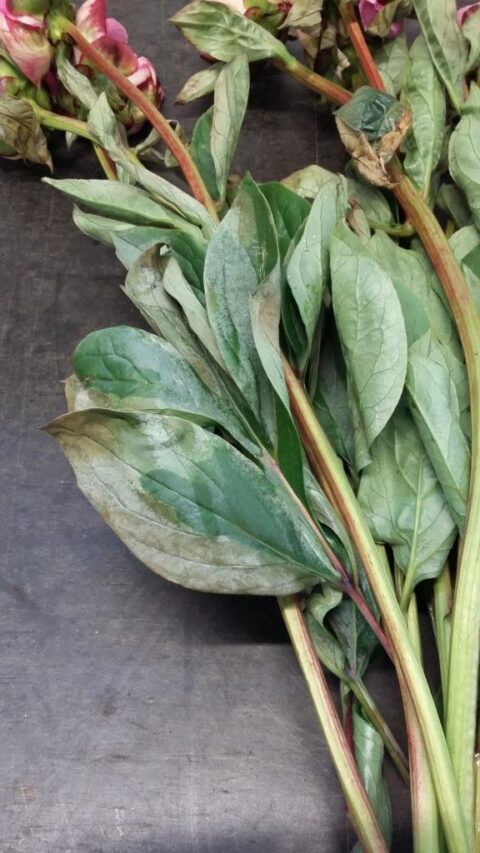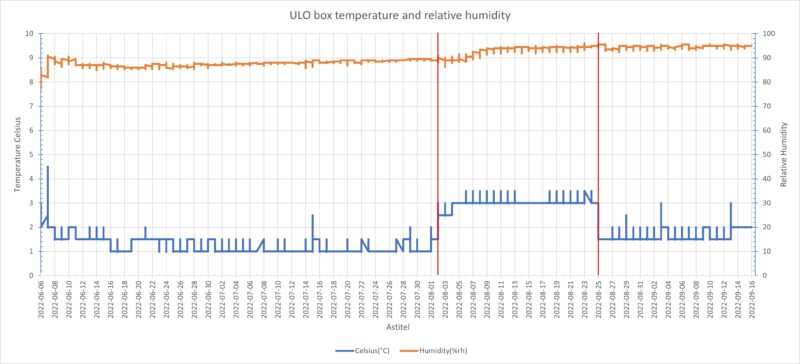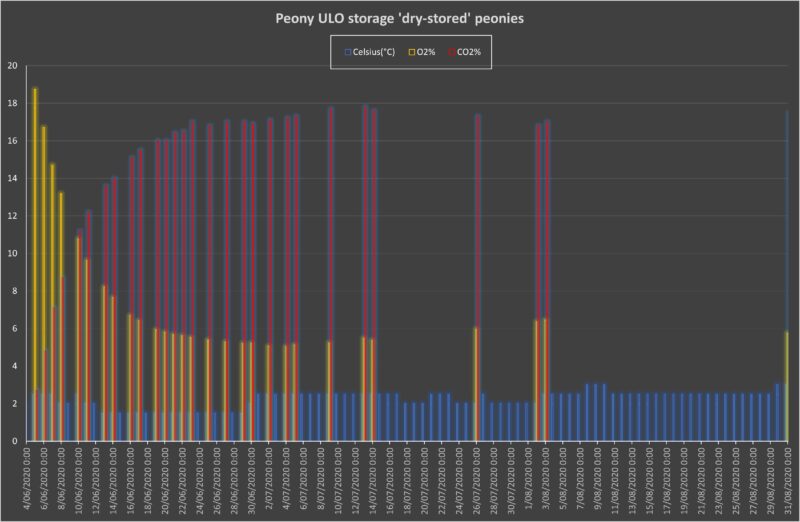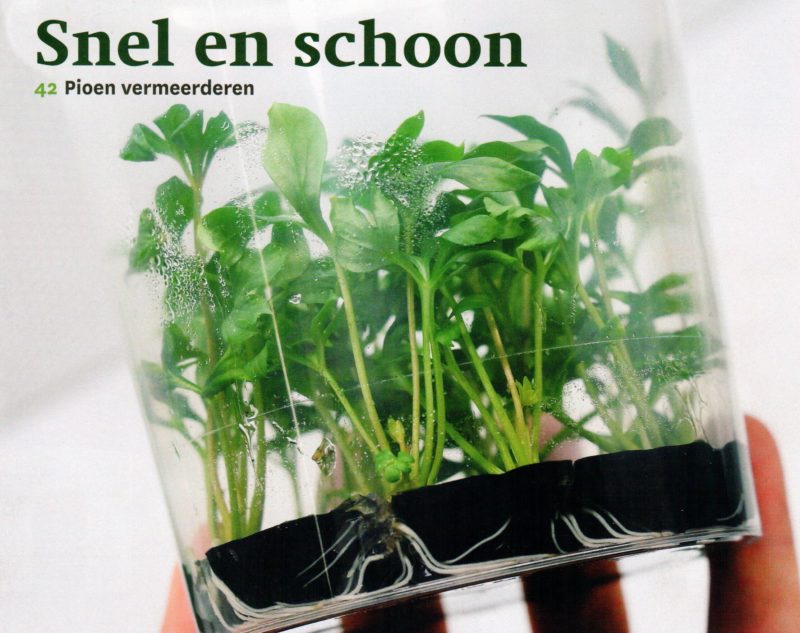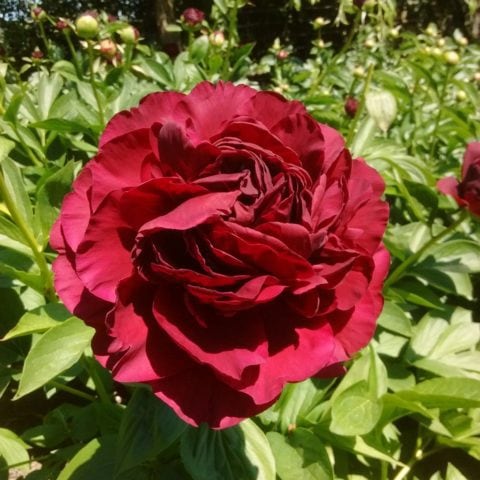Time to describe our ongoing quest for a perfect long term storage procedure for peonies. If you have read last year’s report, you will know that we were rather hopeful to see many good peonies several months after cutting them. Dry storage instead of wet storage (thus no placing them in water), cooling down fast and lowering the oxygen fast in combination with lots of drying silicagel to keep relative humidity in check should do the trick we thought. So, you may be curious as to whether this all materialised?
Well, the short of it: out of 9,000 stems stored this way, 6,000 had to be thrown away after lots and lots of grading during an already busy period in late Summer. To say we’re a bit disappointed would be quite an understatement. The average result for our ULO boxes is shown in the image below.

Not something to look forward to: good ones remaining on the table, bad ones on the floor ready to be composted
But I’m sure you’re interested in the long story, after all, even from failures something can always be learned, Rome wasn’t built in a day.
Let’s first start with the season itself because it was an exceptional one. The main reason for this is that it was the coldest and wettest in decades. Temperatures remained far below longtime averages right up until flowering time, which was some 2-3 weeks later than what we are used to. Of course when that time finally arrived, a heat wave struck, complicating matters even more with everything flowering in a very short time span. This all resulted in very high disease pressure on the plants, with in the general market numerous complaints about botrytis on the foliage and flowerbuds. We ourselves had it more or less under control, although some peony rows that were hard to reach when spraying were also severely affected, but these were wisely not cut. Still, without a doubt, this year we had to start with peony stems that will have had some more latent infections of botrytis, which is not a good starting point, but there’s nothing to choose here. On the positive side however: the cultivar we use most, The Fawn, usually has ‘open’ buds which may be more sensitive to botrytis infection on the inner petals compared to Sarah Bernhard which has closed buds and where the outer petals better protect the inner ones. This year, probably due to the long cold spell, The Fawn also had perfectly closed buds, something we’ve never before experienced.

Unusually closed round buds of The Fawn
The Fawn peonies we used for our ULO storage boxes were cut halfway June, during dry weather, put in the boxes dry (thus no hydrating beforehand), cooled down and then the boxes were closed after some 24 hours with lots of silicagel in it. Into the boxes we also placed an average of 3 containers silicagel / month intended. Each could suck up some 500 ml of water and given that we aimed for 2 – 4 months, some 6 to 12 such containers were placed in the ULO boxes. The number of stems in it was between 700 and 1,100, always leaving free some 10 cm at least from the top cover of the box. The time of closing those boxes was June 12-14 and temperature was kept below 1°C. The advised number of stems in an ULO box is some 800, we also had some with those numbers. The 1,100 was because we could simply but so many in and it would not be surprising to find that other growers would want to do that as well for it obviously restults in a lower cost per stem. The 700 stems box was only half full, this was the very last one we filled, June 14 and it contained some smaller stems that had been laying in the cold storage for over a week but hadn’t been prepared due to time constraints. Given that at that time wholesale prices were at a season’s low and we had one ULO box left but no other peonies to fill it with we simply decided to use them. Even though they were somewhat dried out and although we normally only use larger fresh ones.
As you may know, I’m not alone in this endeavour, because I get some help from a research project named Atmo-Flor which brings together industry stakeholders, Ghent University and the Ornamental Research Centre (PCS). At the PCS, they also closed their ULO boxes at around the same time, with their own grown Sarah Bernhardt and my The Fawn, next to a very few stems I delivered of Amalia Olson, Don Richardson, Madame Claude Tain and Elsa Sass just to have some additional comparisons (not enough to run statistics on them). A difference with me is that they also placed cardboard paper on the sides of the box to suck up some of the excess humidity.
As usual the PCS also placed some stems in a simple cardboard box with plastic in it where the oxygen level would not be decreased but remain at ambient levels. The plastic is rather important here as it means humidity also remains rather high. To avoid excess humidity on the flowers in this plastic they were additionally wrapped into some normal paper as well within the plastic.
Another difference from what I did was that they wanted to test a new fungicide that is often used for long term storage of fruits like apples and pears. In the results it is mentioned as Pr296, because it has no offical approvement for regular use in peonies, but fruit growers here will know it as ‘deccopyr’ by BASF (active ingredient pyrimethanil). This is a fungicide that has to be burned in a closed room; the smoke will then fill this room and cover the peonies which will protect against botrytis and other fungi. So, as they have two ULO boxes at the PCS, they filled both with all cultivars and the only difference between the two boxes was that the contents of one of them had been treated with this experimental fungicide. Mention also that all peonies had received preventive spraying in the field before cutting. My own peonies had been sprayed with the biological/organic fungicide Serenade (active ingredient bacillus amyloliquefaciens strain QST713) and a more conventional one Luna Sensation (fluopyram and trifloxystrobine). The PCS had sprayed them with Signum (boscalid and pyraclostrobin). Those are some of the most efficient fungicides nowadays available.
The stems put in were thus cut and stored dry before closing the boxes. At the PCS they also measured the moisture contents of the leaflets, stems and buds. Thanks to the dry weather at the time of cutting and the dry storage, moisture percentages were comparable to the previous year.
| Moisture contents | 2019 start | 2020 start | 2021 start | 2021 after 10 weeks ULO box | 2021 after 10 weeks cardboard box |
| Sarah Bernhardt | 77% | 73% | 72% | 73% | 73% |
| The Fawn | 78% | 73% | 73% | 74% | 75% |
The moisture contents are calculated simply by weighing the fresh stems, drying them completely out in a special oven until stable of weight, weighing the dry stems; and the difference being the moisture content. The table above shows how they started at some 73% moisture content, both this year and last year, compared to 77% in 2019 when they were first placed in water to hydrate them. Within storage they kept their moisture level more or less, perhaps it even increased very slightly in the conditions they were placed in. In normal storage where they are really kept ‘dry’, thus neither an ULO box nor placed in plastic, they would further dry out (see later).
During the period that the peonies were in those boxes, regular measurements were taken of temperature, oxygen, CO2 and ethylene. As all lids were closed at once, oxygen levels went down very fast. So fast in fact that when I checked a week later, oxygen levels were below 1% in a few boxes. This I had not expected given the results of previous years and I thus opened a few lids to raise oxygen levels more towards 5%. At the same time CO2 reached higher levels, something which might also help deter botrytis, although these high CO2 levels quickly went down when one or more lids were opened. This shows that an O2/CO2 meter, although very expensive, is no wasted money when working with these boxes. At the research centre, measurements were better followed up and they never got this low in oxygen as can be seen from the following graph.
One remarkable find from all measurements were the ethylene levels. Previous years we had already noticed that high levels of ethylene during cold storage don’t seem to result in lower quality or damage, even though in literature levels as low as 10 ppb (parts per billion) have shown to inflict damage on plants. Probably the low temperature protects the peony flowers from this. In the cardboard box ethylene could not accumulate as there was free interchange with outside air and there was an average 32 ppb ethylene concentration there. In the untreated ULO box, the ethylene concentration went up to 1,136 ppb. From previous years there was a clear correlation between high ethylene levels and the presence of botrytis, probably because the latter produces ethylene as well. The researchers were quite happy then to find that in the other ULO box, where the peonies had been treated with pyrimethanil, ethylene levels did remain under control, only to 136 ppb. This raised hopes for suppression of botrytis given the correlation between them in earlier years.

Ethylene concentration in the different treatments at the PCS (green: cardboard paper boxes; red: ULO box; blue: pyrimethanil + ULO box)
Some 10 weeks later we started opening the ULO boxes. The PCS opened everything at once for comparisons, I spread it amongst the whole month of August. Now what did we see?
Despite all the silicagel that should have been enough to keep relative humidity in check, it turned out that not all seasons are equal when it comes to this. From the first box opened in the beginning of August it became already clear that the top cover was dripping wet when I opened it. This was surprising, especially so as the silicagel was not yet fully saturated. The first one I opened only had six containers of silicagel in it as it was meant to be opened after two months. As it turned out, the boxes intended for longer storage, which had 9-12 containers in them, were better (as were the boxes with fewer stems in them), even at the end of August, thus an extra month later. I can only guess to the failure this year, but to me it seems that not the amount of water that could be absorbed is the problem, them being not saturated yet, but rather the fact that it cannot take the water out of the air fast enough. With double the silicagel containers in the ULO boxes for even longer storage the capacity of taking water out of the air in any given time is obviously twice as large.
Long story short, boxes with only 6 silicagel containers were terrible and the peonies full of botrytis. The 12 container versions fared better, botrytis levels were far lower there. But there was another issue. A very large number of them had small transparent to white flecks on the petals. Whilst you had to look good to see this, especially as it often only showed a few petal rows further inside the flower bud, those inconspicuous white marks invariably turned into dead tissue and in turn of course developed botrytis, making them worthless. The PCS did not have this problem, so it may be a consequence of my extremely low oxygen levels the peonies experienced for a short time. On the other hand, not all boxes went so low and that kind of damage showed up in nearly all ULO boxes. The images show the problem pretty clear I think. With the best boxes I had to do careful checking of each and every stem. This was a lot of work and knowing what awaited me each time when I would open another ULO box was quite discouraging. But eventually a few thousand stems could be sold in August to make up for at least some of the losses.
And at the PCS? More or less the same, the boxes were also wet on the inside, although the cardboard paper at the sided did protect the flowers somewhat. The most interesting ULO box was the one with the peonies treated with pyrimethanil. The difference in botrytis incidence was indeed remarkable, with far lower levels of it thanks to the special treatment. However… the fungicide itself did give damage to the leaves and sometimes flower buds. The images show this damage well. It tended to dry up completely when the peony stems were placed in a vase, but dried up foliage is not exactly appealing. The foliage you could of course remove completely, as the flower is the most important part of it and in a bouquet you could hide the naked stem. But sometimes some of the petals also had some of this damage, which is, well, another problem. And: it is no perfect solution to avoid botrytis, you still have to check all flowers individually and remove the infected ones. The grading scheme of botrytis damage on the flower buds is also shown below, but actually only grade 0 and 1 are good enough to be sold. To be a really valuable tool the ULO boxes should offer mostly grade 0 damage quality. As can be seen, we are still a long way from that with ‘no damage’ flower buds constituting only a small sample of the total and buds to be thrown away (grade 3 and 4) being in the range of 10-20%, even after the pyrimethanil treatment. The control ULO treatment nearly had half of the stems thrown away as well. The control storage treatments in the cardboard boxes had even more botrytis.
Vase life was also tested. Right after cutting, they open best obviously. After 10 weeks of storage they don’t open as wide anymore. There was no significant difference then between the ones treated with pyrimethanil or not. Averages of vase life are sometimes heavily influenced by a few flowerbuds that still developed botrytis, showing that not all infections had been seen.

Grading results after long term storage in ULO box and cardboard box, with and without pyrimethanil treatment

The Fawn after three days in water. Left immediately after cutting, middle after 10 weeks ULO, right after 10 weeks ULO + pyrimethanil treatment

Sarah Bernhardt after three days in water. Left immediately after cutting, middle after 10 weeks ULO, right after 10 weeks ULO + pyrimethanil treatment

Madame Claude Tain after three days in water. Left immediately after cutting, middle after 10 weeks ULO, right after 10 weeks ULO + pyrimethanil treatment

Don Richardson after three days in water. Left immediately after cutting, middle after 10 weeks ULO, right after 10 weeks ULO + pyrimethanil treatment
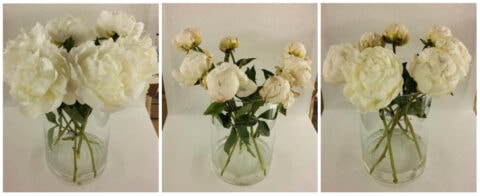
Amalia Olson after three days in water. Left immediately after cutting, middle after 10 weeks ULO, right after 10 weeks ULO + pyrimethanil treatment

Elsa Sass after three days in water. Left immediately after cutting, middle after 10 weeks ULO, right after 10 weeks ULO + pyrimethanil treatment
For comparisons with the regular storage practice, I had bought some Sarah Bernhardt stems at the auction August 12th. These showed the symptoms of long dry storage with some of the outer petals somewhat dried up and the flowers not opening to their full potential. But at least there was no obvious botrytis there. This however is more or less the longest storage period that you can have somewhat acceptable flowers. The ones I saw at the auction the following weeks were progressively worse-looking and more dried out.

Sarah Bernhardt, after long term industry standard storage (dry cold storage)

Sarah Bernhardt, after long term industry standard storage (dry cold storage)
All in all, not much to be happy with, but one small coincidence does shine a light at the end of the tunnel. The last filled ULO box, with the smaller dried out stems, was opened at the end of August and, although there was also some condensation in it, this box contained a far higher proportion of healthy stems. Remarkably, the peonies that went in for the most part dried up, came out all fresh again as if they were able to rehydrate thanks to the higher relative humidity. And with hardly any botrytis or any of those ‘small white flecks’. The stems at the bottom had to be thrown away because there was standing water there from condensation, but the ones above them did look great. What’s more, when these were placed in a vase, they tended to open very well with, as far as I could see, no real difference with freshly cut ones. I think you’d agree with me that the following two images of peonies stored for so long are quite heartening.
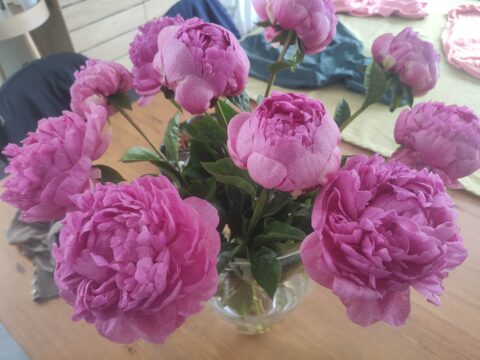
A glimmer of hope, 10 weeks ULO storage
Now what could be the reason for this coincidental success? They had been laying in cold storage for over a week, drying up, thus moisture content of the stems, buds and leaves must have been lower to begin with. I do suppose this is the key to solving the problems at hand, although it will take some extra tweaking to make it perfect. When I talked about this to the PCS, they gave me some further research results on moisture contents.
Stems were placed in water to reach maximum moisture contents. They were then taken out and left to dry for several days in cold storage (2-3°C). Moisture content measurements were taken immediately after hydration, after 4 days and after 11 days in cold storage. The results are shown in the table below and show that it is somewhat cultivar specific, with The Fawn after 11 days reaching 64% moisture content in the flower bud. When placing these last ones in water, they had dried out too much to be able to absorb any water, whereas all others still had the ability to do so. There is thus a minimum moisture content needed for them to be able to rehydrate again, which is probably around 68-70%. Many commercial long term stored peonies are stored in cold rooms that can control relative humidity and are thus able to delay too much drying out. ULO cold storage rooms with relative humidity control might also be able to do the trick, but of course these have the disadvantage that you cannot take out a small number of peony stems at a time, which is the main selling point of the ULO boxes.
| Moisture contents | Start | after 4 days 2-3°C dry storage | after 11 days 2-3°C dry storage |
| Sarah Bernhardt | |||
| flower bud | 78% | 74% | 69% |
| leaf | 73% | 70% | 67% |
| stem | 76% | 72% | 67% |
| total | 76% | 72% | 68% |
| The Fawn | |||
| flower bud | 76% | 70% | 64% |
| leaf | 77% | 73% | 66% |
| stem | 77% | 72% | 66% |
| total | 77% | 72% | 66% |
To conclude we might say there are still possibilities despite all setbacks. Drying the stems out prior to closing the boxes is arguably the way to go in the future. How much, how long and how to keep relative humidity in the ULO boxes below 100% still has to be researched further. The extra pyrimethanil treatment might also work better with a lower dosage, perhaps still protecting (partly) against botrytis but without the residu damage. A lot left to research further. Let’s hope next year we won’t have to throw away another 6,000 stems.
As to other people’s results with the ULO boxes, the company that sells them, Janny MT, is regularly in touch with me as they really want to make progress. Unfortunately my colleagues that use them (in sometimes large numbers) have their lips sealed and no trustworthy stories can really be found.
Now, if you would have any ideas to share about long term storage, you are free to do so in the comments below, it would be quite nice to know we aren’t merely writing all this for ourself ;-)
Download the following reports if you like even more info:
The PCS Research Report ULO storage 2021.
The PCS Research report moisture contents peonies
Both are in dutch language, but you can translate the documents.











